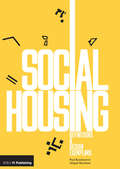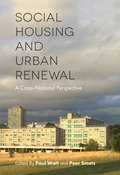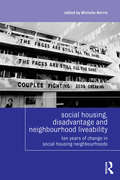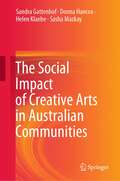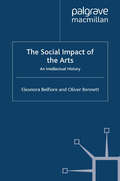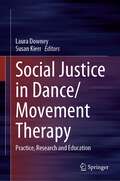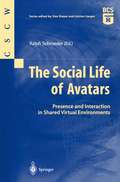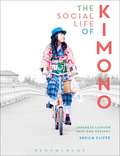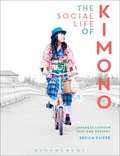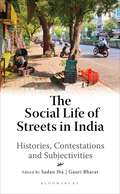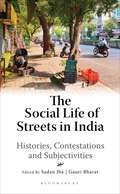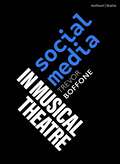- Table View
- List View
Social Housing: Definitions and Design Exemplars
by Paul Karakusevic Abigail BatchelorThis is a growing sector undergoing a huge period of change - with local authorities able to build their own housing for the first time in decades. Social Housing: Definitions and Design Exemplars explores how social/affordable housing has been delivered and designed with success throughout the UK in the last 10 years. Weaving together exemplar case studies, essays and interviews with social housing pioneers and clients, this book demonstrates real-life best practice responses to the challenges associated with housing provision, with a focus on design ideas.
Social Housing and Urban Renewal: A Cross-National Perspective
by Paul Watt Peer SmetsThis book offers a cross-national perspective on contemporary urban renewal in relation to social rental housing. Social housing estates – as developed either by governments (public housing) or not-for-profit agencies – became a prominent feature of the 20th century urban landscape in Northern European cities, but also in North America and Australia. Many estates were built as part of earlier urban renewal, ‘slum clearance’ programs especially in the post-World War 2 heyday of the Keynesian welfare state. During the last three decades, however, Western governments have launched high-profile ‘new urban renewal’ programs whose aim has been to change the image and status of social housing estates away from being zones of concentrated poverty, crime and other social problems. This latest phase of urban renewal – often called ‘regeneration’ – has involved widespread demolition of social housing estates and their replacement with mixed-tenure housing developments in which poverty deconcentration, reduced territorial stigmatization, and social mixing of poor tenants and wealthy homeowners are explicit policy goals. Academic critical urbanists, as well as housing activists, have however queried this dominant policy narrative regarding contemporary urban renewal, preferring instead to regard it as a key part of neoliberal urban restructuring and state-led gentrification which generate new socio-spatial inequalities and insecurities through displacement and exclusion processes. This book examines this debate through original, in-depth case study research on the processes and impacts of urban renewal on social housing in European, U.S. and Australian cities. The book also looks beyond the Western urban heartlands of social housing to consider how renewal is occurring, and with what effects, in countries with historically limited social housing sectors such as Japan, Chile, Turkey and South Africa.
Social Housing and Urban Renewal: A Cross-National Perspective
by Paul Watt Peer SmetsThis book offers a cross-national perspective on contemporary urban renewal in relation to social rental housing. Social housing estates – as developed either by governments (public housing) or not-for-profit agencies – became a prominent feature of the 20th century urban landscape in Northern European cities, but also in North America and Australia. Many estates were built as part of earlier urban renewal, ‘slum clearance’ programs especially in the post-World War 2 heyday of the Keynesian welfare state. During the last three decades, however, Western governments have launched high-profile ‘new urban renewal’ programs whose aim has been to change the image and status of social housing estates away from being zones of concentrated poverty, crime and other social problems. This latest phase of urban renewal – often called ‘regeneration’ – has involved widespread demolition of social housing estates and their replacement with mixed-tenure housing developments in which poverty deconcentration, reduced territorial stigmatization, and social mixing of poor tenants and wealthy homeowners are explicit policy goals. Academic critical urbanists, as well as housing activists, have however queried this dominant policy narrative regarding contemporary urban renewal, preferring instead to regard it as a key part of neoliberal urban restructuring and state-led gentrification which generate new socio-spatial inequalities and insecurities through displacement and exclusion processes. This book examines this debate through original, in-depth case study research on the processes and impacts of urban renewal on social housing in European, U.S. and Australian cities. The book also looks beyond the Western urban heartlands of social housing to consider how renewal is occurring, and with what effects, in countries with historically limited social housing sectors such as Japan, Chile, Turkey and South Africa.
Social Housing, Disadvantage, and Neighbourhood Liveability: Ten Years of Change in Social Housing Neighbourhoods (Housing and Society Series)
by Michelle NorrisIn a groundbreaking longitudinal study, researches studied seven similar social housing neighbourhoods in Ireland to determine what factors affected their liveability. In this collection of essays, the same researchers return to these neighbourhoods ten years later to see what’s changed. Are these neighbourhoods now more liveable or leaveable? Social Housing, Disadvantage and Neighbourhood Liveability examines the major national and local developments that externally affected these neighbourhoods: the Celtic tiger boom, area-based interventions, and reforms in social housing management. Additionally, the book examines changes in the culture of social housing through studies of crime within social housing, changes in public service delivery, and media reporting on social housing. Social Housing, Disadvantage and Neighbourhood Liveability offers a new body of data valuable to researchers in Ireland and abroad on how to create more equitable and liveable social housing.
Social Housing, Disadvantage, and Neighbourhood Liveability: Ten Years of Change in Social Housing Neighbourhoods (Housing and Society Series)
by Michelle NorrisIn a groundbreaking longitudinal study, researches studied seven similar social housing neighbourhoods in Ireland to determine what factors affected their liveability. In this collection of essays, the same researchers return to these neighbourhoods ten years later to see what’s changed. Are these neighbourhoods now more liveable or leaveable? Social Housing, Disadvantage and Neighbourhood Liveability examines the major national and local developments that externally affected these neighbourhoods: the Celtic tiger boom, area-based interventions, and reforms in social housing management. Additionally, the book examines changes in the culture of social housing through studies of crime within social housing, changes in public service delivery, and media reporting on social housing. Social Housing, Disadvantage and Neighbourhood Liveability offers a new body of data valuable to researchers in Ireland and abroad on how to create more equitable and liveable social housing.
Social Housing in Performance: The English Council Estate on and off Stage (Methuen Drama Engage)
by Katie Beswick Mark Taylor-Batty Enoch BraterThis book explores the ways that council estates have been represented in England across a range of performance forms. Drawing on examples from mainstream, site-specific and resident-led performance works, it considers the political potential of contemporary performance practices concerned with the council estate. Depictions of the council estate are brought into dialogue with global representations of what Chris Richardson and Hans Skott-Myhre call the 'hood', to tease out the specific features of the British context and situate the work globally. Katie Beswick's study provides a timely contribution to the ongoing national and global interest in social housing. As the housing market grows ever more insecure, and estates are charged with political rhetoric, theatre and socially engaged art set or taking place on estates takes on a new potency. Mainstream theatre works examined include Rita, Sue and Bob Too and A State Affair at the Soho Theatre, Port at the National Theatre, and DenMarked at the Battersea Arts Centre. The book also explores the National Youth Theatre's Slick and Roger Hiorns' Seizure, as well as community-based and resident led performances by Fourthland, Jordan McKenzie, Fugitive Images and Jane English.
Social Housing in Performance: The English Council Estate on and off Stage (Methuen Drama Engage)
by Enoch Brater Mark Taylor-Batty Katie BeswickThis book explores the ways that council estates have been represented in England across a range of performance forms. Drawing on examples from mainstream, site-specific and resident-led performance works, it considers the political potential of contemporary performance practices concerned with the council estate. Depictions of the council estate are brought into dialogue with global representations of what Chris Richardson and Hans Skott-Myhre call the 'hood', to tease out the specific features of the British context and situate the work globally. Katie Beswick's study provides a timely contribution to the ongoing national and global interest in social housing. As the housing market grows ever more insecure, and estates are charged with political rhetoric, theatre and socially engaged art set or taking place on estates takes on a new potency. Mainstream theatre works examined include Rita, Sue and Bob Too and A State Affair at the Soho Theatre, Port at the National Theatre, and DenMarked at the Battersea Arts Centre. The book also explores the National Youth Theatre's Slick and Roger Hiorns' Seizure, as well as community-based and resident led performances by Fourthland, Jordan McKenzie, Fugitive Images and Jane English.
The Social Impact of Creative Arts in Australian Communities
by Sandra Gattenhof Donna Hancox Helen Klaebe Sasha MackayThis book brings together discussions about Australian arts policy and funding, outcomes of arts engagement in terms of social inclusion, well-being and education. It presents exemplars of creative programs or case studies that build capacity and lasting impact for communities in urban and regional Australia. This book describes the impact of the arts using narrative case studies. Through this, it develops conceptual understanding and frameworks that can be used to dynamically assess the value and impact of arts engagement across the three types of cultural value: intrinsic value, instrumental value and institutional value. It focuses on how arts engagement creates, supports and extends factors such as well-being, social inclusion and educational achievement. This book provides an innovative examination of the evidence from Australian projects depicting the impact of the arts on a range of indicators and sectors.
The Social Impact of the Arts: An Intellectual History
by Eleonora Belfiore Oliver BennettAn intellectual history of contrasting ideas around the power of the arts to bring about personal and societal change - for better and worse. A fascinating account of the value and functions of the arts in society, in both the private sphere of individual emotions and self-development and public sphere of politics and social distinction.
Social Justice Design and Implementation in Library and Information Science
by Bharat MehraSocial Justice Design and Implementation in Library and Information Science presents a range of case studies that have successfully implemented social justice as a designed strategy to generate community-wide changes and social impact. Each chapter in the collection presents innovative practices that are strategized as intentional, deliberate, systematic, outcome-based, and impact-driven. They demonstrate effective examples of social justice design and implementation in LIS to generate meaningful outcomes across local, regional, national, and international settings. Including reflections on challenges and opportunities in academic, public, school, and special libraries, museums, archives, and other information-related settings, the contributions present forward-looking strategies that transcend historical and outdated notions of neutral stance and passive bystanders. Showcasing the intersections of LIS concepts and interdisciplinary theories with traditional and non-traditional methods of research and practice, the volume demonstrates how to further the social justice principles of fairness, justice, equity/equality, and empowerment of all people, including those on the margins of society. Social Justice Design and Implementation in Library and Information Science will be of great interest to LIS educators, scholars, students, information professionals, library practitioners, and all those interested in integrating social justice and inclusion advocacy into their information-related efforts to develop impact-driven, externally focused, and community-relevant outcomes.
Social Justice Design and Implementation in Library and Information Science
by Bharat MehraSocial Justice Design and Implementation in Library and Information Science presents a range of case studies that have successfully implemented social justice as a designed strategy to generate community-wide changes and social impact. Each chapter in the collection presents innovative practices that are strategized as intentional, deliberate, systematic, outcome-based, and impact-driven. They demonstrate effective examples of social justice design and implementation in LIS to generate meaningful outcomes across local, regional, national, and international settings. Including reflections on challenges and opportunities in academic, public, school, and special libraries, museums, archives, and other information-related settings, the contributions present forward-looking strategies that transcend historical and outdated notions of neutral stance and passive bystanders. Showcasing the intersections of LIS concepts and interdisciplinary theories with traditional and non-traditional methods of research and practice, the volume demonstrates how to further the social justice principles of fairness, justice, equity/equality, and empowerment of all people, including those on the margins of society. Social Justice Design and Implementation in Library and Information Science will be of great interest to LIS educators, scholars, students, information professionals, library practitioners, and all those interested in integrating social justice and inclusion advocacy into their information-related efforts to develop impact-driven, externally focused, and community-relevant outcomes.
Social Justice in Dance/Movement Therapy: Practice, Research and Education
This book demonstrates the use of dance/movement therapy to directly counteract social injustices and promote healing in international settings. It also demonstrates the potential for dance/movement therapy in prevention and wellness in clinical and community settings. The use of improvisational and creative dance is presented throughout the book as a tremendously clear, strong and powerful inroad to healing in every setting. The chapters in this book do not directly address social justice in dance/movement therapy, but rather provide provoking social justice related positions. This call for a provoking re-examination of the definition of dance/movement therapy is fitting as we—as a community—challenge our identity as dance/movement therapists, educators, supervisors and as human beings who have internalized oppression in various forms through our many identifiers and the unique intersections of those identifiers. The editors and authors posit that social justice cannot be fully addressed by focusing solely on the social issues. Rather, we must be aware of where and how the social issues come into the individual(s), the setting, and the therapy process itself.Chapter “‘Breaking Free': One Adolescent Woman's Recovery from Dating Violence Through Creative Dance" is available open access under a Creative Commons Attribution 4.0 International license via link.springer.com.
The Social Life of Avatars: Presence and Interaction in Shared Virtual Environments (Computer Supported Cooperative Work)
by RalphSchroederVirtual reality (VR) technology has been developed commercially since the early 1990s [1]. Yet it is only with the growth of the Internet and other high-bandwidth links that VR systems have increasingly become networked to allow users to share the same virtual environment (VE). Shared YEs raise a number of interesting questions: what is the difference between face-to-face interaction and interaction between persons inside YEs? How does the appearance of the "avatar" - as the graphical representation of the user has become known - change the nature of interaction? And what governs the formation of virtual communities? This volume brings together contributions from social scientists and computer scientists who have conducted research on social interaction in various types of YEs. Two previous volumes in this CSCW book series [2, 3] have examined related aspects of research on YEs - social navigation and collaboration - although they do not always deal with VRIVEs in the sense that it is used here (see the definition in Chapter 1). The aim of this volume is to explore how people interact with each other in computer-generated virtual worlds.
The Social Life of Kimono: Japanese Fashion Past and Present (Dress, Body, Culture)
by Sheila CliffeThe kimono is an iconic garment with a history as rich and colourful as the textiles from which it is crafted. Deeply associated with Japanese culture both past and present, it has often been thought of as a highly gendered, rigidly traditional and unchanging national costume. This book challenges that perception, revealing the nuanced meanings and messages behind the kimono from the point of view of its wearers and producers, many of whom – both men and women – see the garment as a vehicle for self-expression. Taking a material culture approach, The Social Life of Kimono is the first study to combine the history of the kimono as a fashionable garment with an in-depth exploration of its multifaceted role today on both the street and the catwalk. Through case studies covering historical advertising campaigns, fashion magazines, interviews with contemporary kimono designers, large scale and small craft producers, and consumers who choose to wear them, The Social Life of Kimono gives a unique insight into making and meaning of this complex garment.
The Social Life of Kimono: Japanese Fashion Past and Present (Dress, Body, Culture)
by Sheila CliffeThe kimono is an iconic garment with a history as rich and colourful as the textiles from which it is crafted. Deeply associated with Japanese culture both past and present, it has often been thought of as a highly gendered, rigidly traditional and unchanging national costume. This book challenges that perception, revealing the nuanced meanings and messages behind the kimono from the point of view of its wearers and producers, many of whom – both men and women – see the garment as a vehicle for self-expression. Taking a material culture approach, The Social Life of Kimono is the first study to combine the history of the kimono as a fashionable garment with an in-depth exploration of its multifaceted role today on both the street and the catwalk. Through case studies covering historical advertising campaigns, fashion magazines, interviews with contemporary kimono designers, large scale and small craft producers, and consumers who choose to wear them, The Social Life of Kimono gives a unique insight into making and meaning of this complex garment.
The Social Life of Streets in India: Histories, Contestations and Subjectivities
by Sadan Jha Gauri BharatStreets are places that stimulate activities, interactions, behaviours and, by extension, controls. Yet, within the built environment discourse, the street is first and foremost conceptualised as a mute backdrop to movement-vehicular or pedestrian. The Covid-19 pandemic brought renewed focus on the street as the space of networks, flows and mobilities as the 'lockdown' was the preferred mode of controlling the spread of the disease.The Social Life of Streets in India: Histories, Contestations and Subjectivities endeavours to understand the complexities of social dynamics of streets in relation to spatiality and materiality in the Indian milieu. It draws from a diverse body of scholarship and varied disciplinary leanings and engages with three broad strands: historical aspects of streets, the physicality of street as a built environment and social science discourse mediated through anthropology, urban geography, social theory and urban studies.Further the volume deliberates on questions such as: How do we look at streets and, in particular, how do we document and conceptualise streets in the Indian context that highlights the particularities of South Asian milieus? Is the street public? Is it merely a physical space? How does the street in its physicality and in its built form enter or respond to the metaphorical, the literary, the methodological and the social?
The Social Life of Streets in India: Histories, Contestations and Subjectivities
by Sadan Jha Gauri BharatStreets are places that stimulate activities, interactions, behaviours and, by extension, controls. Yet, within the built environment discourse, the street is first and foremost conceptualised as a mute backdrop to movement-vehicular or pedestrian. The Covid-19 pandemic brought renewed focus on the street as the space of networks, flows and mobilities as the 'lockdown' was the preferred mode of controlling the spread of the disease.The Social Life of Streets in India: Histories, Contestations and Subjectivities endeavours to understand the complexities of social dynamics of streets in relation to spatiality and materiality in the Indian milieu. It draws from a diverse body of scholarship and varied disciplinary leanings and engages with three broad strands: historical aspects of streets, the physicality of street as a built environment and social science discourse mediated through anthropology, urban geography, social theory and urban studies.Further the volume deliberates on questions such as: How do we look at streets and, in particular, how do we document and conceptualise streets in the Indian context that highlights the particularities of South Asian milieus? Is the street public? Is it merely a physical space? How does the street in its physicality and in its built form enter or respond to the metaphorical, the literary, the methodological and the social?
Social Media and the Contemporary City
by Eric Sauda Ginette Wessel Alireza KarduniThe widespread adoption of smartphones has led to an explosion of mobile social media data, more than a billion messages per day that continuously track location, content, and time. Social Media in the Contemporary City focuses on the effects of social media on local communities and urban space in a variety of political and economic settings related to social activism, informal economic activity, public art, and global extremism. The book covers events ranging from Banksy art installations, mobile food trucks, and underground restaurants, to a Black Lives Matter protest, the Christchurch mosque shootings, and the Pulse nightclub shooting. The interplay between urban space, local community, and social media in each case study requires diverse methodologies that are both computational (i.e. machine learning, social network analysis, and natural language processing) and ethnographic (i.e. semi-structured interviews, thematic analysis, and site analysis). The book views social media not as a replacement for the local community or urban space but rather as a translation of the uses and meanings of all three realms. The book will be of interest to students, researchers, and instructors in a number of disciplines including urban design/planning, media studies, geography, and communications.
Social Media and the Contemporary City
by Eric Sauda Ginette Wessel Alireza KarduniThe widespread adoption of smartphones has led to an explosion of mobile social media data, more than a billion messages per day that continuously track location, content, and time. Social Media in the Contemporary City focuses on the effects of social media on local communities and urban space in a variety of political and economic settings related to social activism, informal economic activity, public art, and global extremism. The book covers events ranging from Banksy art installations, mobile food trucks, and underground restaurants, to a Black Lives Matter protest, the Christchurch mosque shootings, and the Pulse nightclub shooting. The interplay between urban space, local community, and social media in each case study requires diverse methodologies that are both computational (i.e. machine learning, social network analysis, and natural language processing) and ethnographic (i.e. semi-structured interviews, thematic analysis, and site analysis). The book views social media not as a replacement for the local community or urban space but rather as a translation of the uses and meanings of all three realms. The book will be of interest to students, researchers, and instructors in a number of disciplines including urban design/planning, media studies, geography, and communications.
Social Media for Fashion Marketing: Storytelling in a Digital World
by Wendy K. BendoniSocial Media for Fashion Marketing uses cutting edge case studies and detailed interviews to show how the business of fashion is changing in the digital landscape. Bendoni (@BendoniStyle) also considers the psychological impact of being a hyper-connected consumer and the generational gaps in social media communication. Using academic research, alongside her 25 years of fashion marketing experience, Bendoni offers a clear picture of the changing narrative of storytelling, social confirmation, digital nesting and how to use data to shape a brand's online presence.With practical and critical thinking activities to hone your skills into professional practice, this is the ultimate guide to social marketing, promotion, SEO, branding and communication.Featured topics- Rules of Digital Storytelling- Rethinking Gamification- Strategic Digital Marketing- The Role of Citizen Journalists- The Social Media Looking Glass- World of Influencer Marketing- Visual Consumption Economy- Global Perspective of Social Media
Social Media for Fashion Marketing: Storytelling in a Digital World
by Wendy K. BendoniSocial Media for Fashion Marketing uses cutting edge case studies and detailed interviews to show how the business of fashion is changing in the digital landscape. Bendoni (@BendoniStyle) also considers the psychological impact of being a hyper-connected consumer and the generational gaps in social media communication. Using academic research, alongside her 25 years of fashion marketing experience, Bendoni offers a clear picture of the changing narrative of storytelling, social confirmation, digital nesting and how to use data to shape a brand's online presence.With practical and critical thinking activities to hone your skills into professional practice, this is the ultimate guide to social marketing, promotion, SEO, branding and communication.Featured topics- Rules of Digital Storytelling- Rethinking Gamification- Strategic Digital Marketing- The Role of Citizen Journalists- The Social Media Looking Glass- World of Influencer Marketing- Visual Consumption Economy- Global Perspective of Social Media
Social Media in Musical Theatre (Topics in Musical Theatre)
by Trevor BoffoneThis book introduces readers to the widespread phenomenon of how social media platforms such as YouTube, Twitter, and TikTok become an extension of long-standing aspects of musical theatre engagement. Although casual observers may dismiss social media's import, social media has revolutionized the field of musical theatre since the early days of Web 2.0 with spaces such as AOL, LiveJournal, and Myspace. Now, as social media continues to grow in relevance, the nuanced ways in which digital platforms influence musical culture remain ripe for study. Social Media in Musical Theatre moves beyond viewing social media merely as a passing fad or a space free from critical engagement. Rather, this volume takes a serious look at the critical role social media play in musicals, thus challenging how social media users and musical theatre-makers alike approach digital spaces. This book introduces the relationship between musical theatre and social media in the 21st century as well as methods to study social media's influence on musicals through three in-depth case studies organized around marketing on YouTube, fan engagement on Twitter, and new musical development on TikTok.
Social Media in Musical Theatre (Topics in Musical Theatre)
by Trevor BoffoneThis book introduces readers to the widespread phenomenon of how social media platforms such as YouTube, Twitter, and TikTok become an extension of long-standing aspects of musical theatre engagement. Although casual observers may dismiss social media's import, social media has revolutionized the field of musical theatre since the early days of Web 2.0 with spaces such as AOL, LiveJournal, and Myspace. Now, as social media continues to grow in relevance, the nuanced ways in which digital platforms influence musical culture remain ripe for study. Social Media in Musical Theatre moves beyond viewing social media merely as a passing fad or a space free from critical engagement. Rather, this volume takes a serious look at the critical role social media play in musicals, thus challenging how social media users and musical theatre-makers alike approach digital spaces. This book introduces the relationship between musical theatre and social media in the 21st century as well as methods to study social media's influence on musicals through three in-depth case studies organized around marketing on YouTube, fan engagement on Twitter, and new musical development on TikTok.
Social-Media und Museum: Wie digitale Bilder und ästhetische Praktiken die Kunsterfahrung verändern (Edition Museum #84)
by Sarah Maria UllrichWas passiert, wenn Besucher*innen von Kunstmuseen die Exponate der Ausstellungsräume fotografieren und die bildlichen Aufnahmen auf Social-Media-Plattformen neu kontextualisieren? Sarah Maria Ullrich zeigt anhand dichter ethnografischer Beschreibungen, dass diese vermeintlich banalen Praktiken im Kern eines vielschichtigen Spannungsfelds stehen, in dem sich nichts weniger als die Frage verhandelt, wie digitale Medien die moderne Museumserfahrung verändern. Sie illustriert, wie mediale Visualisierungstechniken als neue Formen des Widerstands im Kontext gesellschaftspolitischer Aushandlungsprozesse fungieren und damit nicht zuletzt auch die Deutungshoheit etablierter musealer Institutionen ins Wanken bringen.
The Social Neuroscience of Intergroup Relations: Prejudice, can we cure it?
by Sylvia TerbeckThe Social Neuroscience of Intergroup Relations; Prejudice can we cure it?” is a highly interdisciplinary book. It includes latest theories and research from: Social Psychology, Ethics, Psychopharmacology, as well as Social Neuroscience. The book is also based on the author’s team research. The book describes experimental studies which have suggested that fear of the out-group might play a role in prejudice. Amongst others, one experiment that received large media coverage will be illustrated; a study which found that the drug propranolol reduced racial bias. However, is there a “cure” for prejudice? But even if there were biological methods to reduce prejudice are there not ethical and medical problems associated with this? However, we are our brain; thus not only soul searching, but also a drug can change the core of a person.
